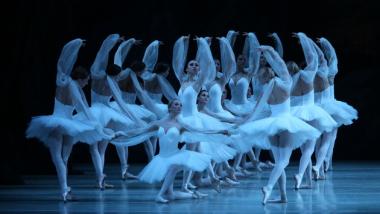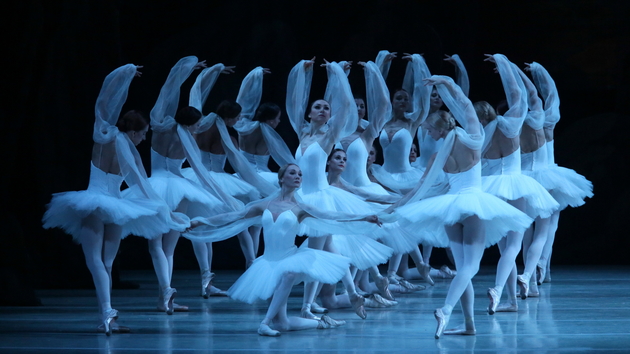
Fulfilling every wish in the beating heart of the true balletomane, the Mariinsky Ballet’s sumptuous full-length La Bayadère, the gloriously tragic love story of Nikia, an enslaved water bearer, and the wealthy warrior Solor, remains the soul of classical ballet. Its purities and exactitudes, lavish sets and costumes, and the company’s beauty, as much as its storyline, were rapturously received Saturday afternoon, Nov. 2, at Zellerbach Hall, where Cal Performances hosted the St. Petersburg troupe for a five-day visit, along with the excellent Mariinsky Ballet Orchestra. Led by Artistic and General Director Valery Gergiev with Acting Ballet Director Yuri Fateev, and conducted by Alexei Repnikov, this performance had it all.
Full credit to the glories of the principal dancers, whose technical prowess was matched by their sheer soulfulness. Because of their genius as ballet dancers, the story took care of itself — the bodies embodied each twist and turn of the tale.
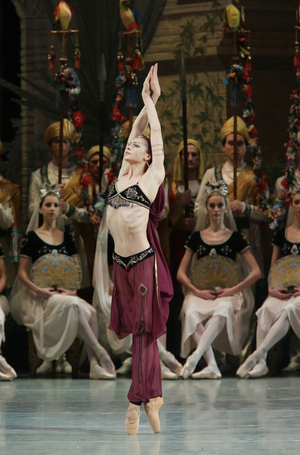
Ekaterina Kondaurova’s stunning Nikia seemed to move on her own breath, her extensions magical, her upper body eloquent, her arms easily and gently in service to a back of remarkable suppleness, and her pointe shoes arching into perfect, easy c’s. Yekaterina Chebykina’s mean and aristocratic Gamzatti, who contrived to kill Nikia, her rival for Solor, was tireless and gorgeous, with icy, impassioned dancing that made her difficult to despise. Her Gamzatti was clearly more menacing than Nikia. As for Andrei Yermakov, who sensitively and reliably partnered both ballerinas, his Solor was a perfect embodiment of a charming, if slightly obtuse, dude of regal bearing and an amazing, indefatigable facility for leaps, spins, and beating jumps.
The corps and soloists were absolutely immaculate and unfaltering. The dancers, not just in the “Shades” sequence but also in Act 2’s engagement party festivities, look almost identical in conformation and style, but their beauty and warmth in their variations as well as their corps work is transcendently compelling, as a file of robots could never be. (That’s also the way the corps of Wilis looked in the Giselle at the Mariinsky in 2016: dead, yet to die for.)
Back to a little history. Conceived as a star vehicle for Marius Petipa’s favorite ballerina, Yekaterina Vazem, La Bayadère initially met with many objections, mostly from the ballerina herself, who didn’t like the entrance Petipa gave her. But by the time it premiered, she said Bayadère was her favorite ballet.
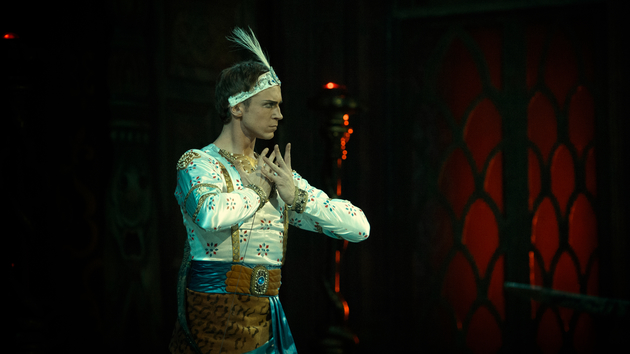
The version seen most often in the U.S., as well as in Australia, Sweden, and England, was choreographed by the former reigning Nikia (until she defected), Natalia Makarova, for American Ballet Theatre, where she was a remarkable principal dancer who also starred in her own creation. She was a genius whose muscle memory, choreography, and coaching successfully meshed and matched, stylistically and dramatically, elements of each act of the original into an entirely new and stunning 1980 production that I devoutly hope to clap eyes on once again sometime. Her “Shades” scene entered the San Francisco Ballet repertory in 2000 and ran most recently during the 2015 season. With any luck, it will play again soon. Rudolf Nureyev choreographed his own full- length La Bayadère for the Paris Opera Ballet; it was his final project as artistic director before his death in 1993.
The ballet Marius Petipa choreographed in 1877, now performed as revised in 1941 by Vakhtang Chabukiani and Vladimir Ponomarev, has a rambling history in the Western world. Set to music by Ludwig Minkus, it’s gone from four acts down to three, up to four, down to three, thence to one, and back to three. These days it’s looked on a bit askance. To fault La Bayadère for its pseudo-Oriental, pseudo-oligarchical, imperialist depictions seems like poking holes in a cream puff. It doesn’t look or feel particularly Indian or Hindu; the imagery on the walls is cartoony rather than authentic, and the “trophies” paraded from a hunt — the large elephant on wheels and the floppy stuffed-toy tiger on a stretcher — look merely cute.
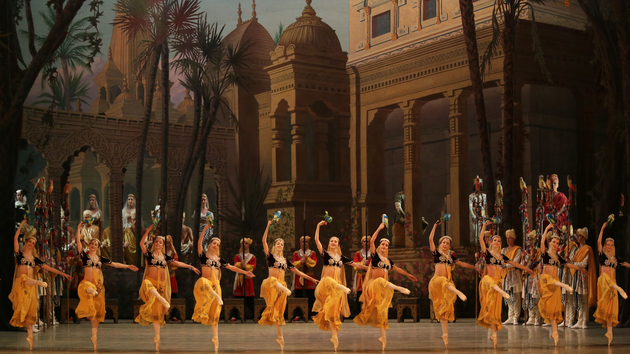
But considering the #MeToo era worldwide, bringing new light to abuses of women, Bayadère seems a little surprisingly on point. The bad —or baddest — guy here is the supposedly celibate High Brahmin, who doffs his helmet in bald supplication to the bayadère, Nikia, hoping to be with her. She turns him down flat; she is in love with the warrior Solor, who has pledged his fidelity. Unfortunately, however, Solor has been promised since boyhood to the Rajah Dugmanta’s daughter, the beautiful Gamzatti. Solor semi-piggishly likes Gamzatti, he really likes her, though he’s reminded of his recent pledge to Nikia. But the High Brahmin tips off the Rajah to Nikia’s love for Solor, and the Rajah plans to kill her.
Things go from bad to worse. Nikia won’t hear of Gamzatti’s demand that she give up Solor, and, in fact, she tries and fails to kill Gamzatti with a dagger. At the lavish engagement feast, Gamzatti’s dad sends Nikia a basket of flowers with a poisonous snake hidden in them. As Nikia dances ecstatically with the flowers, thinking them from Solor, the snake bites her. The High Brahmin offers her an antidote in exchange for her affections as she lies there, and she spurns him one last time and dies.
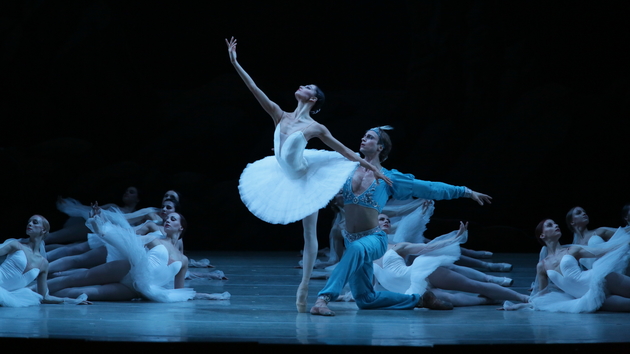
Time now for Solor to launch into romantic guilty regrets via opium-smoked dreams. Dozing on his bed, he conjures up Nikia, in fact a panoply of 32 Nikias, plus soloists, in classical ballet’s legendary “Kingdom of the Shades.” One by ghostly one, the Shades materialize, winding their way through the Himalayas, behind a misty scrim that thankfully gives way so we can see the beauty of their wraith-ness, their luminescence in gauzy white as they step forward and arch their spines backward, each leaving room for a successor Shade, creating a devotional tableau without equal. It all stops after that; there is no next scene, no destruction of the temple as ordained in the original production and also in the ABT version. Yet it seems complete. Nikia and Solor will be together; we can tell from their final pas de deux. What more is there to say?
So what makes the “Kingdom of the Shades” immortal? Might as well ask why there are Himalayas or ballerinas. The short answer is there’s no ballet — or none your reviewer can think of — that calls up such a ravishing combination of simplicity and difficulty.
Petipa’s genius, and the expansiveness of its staging, the requirements it embodies — the training, the practice, the devotion leading to the performance, every performance, seems to touch all who are in it and all who see it. It’s expansive and endless, yet its magic world is a gift that’s self-contained. It’s everything — and yet it’s just a ballet.

